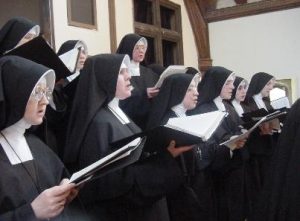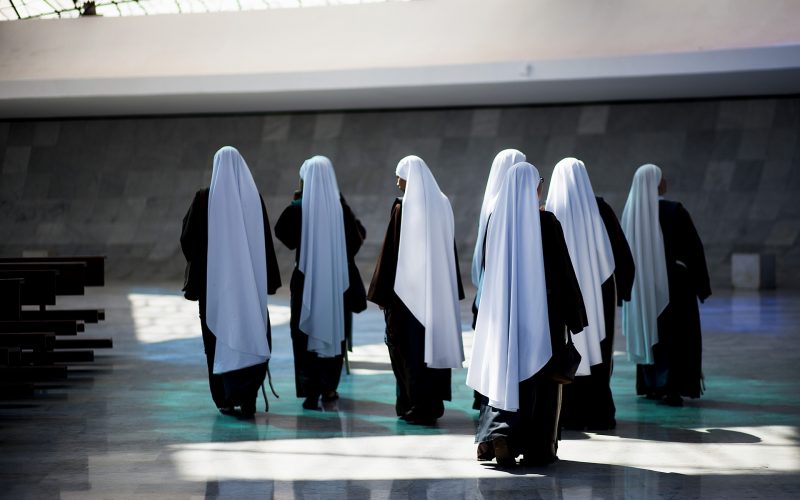Catholic nuns and the Bene Gesserit in Dune have much in common: from titles and clothing to discipline and influence – these are women with a mission. As sisters clothed in black, they are committed followers of their order who make a difference in their communities. Yet there is also a key difference in that the fictional Bene Gesserit do not answer to a male authority figure. This likely reflects author Frank Herbert’s interest in providing women with more agency than they had in the confines of real-world religions. According to his son Brian Herbert, Frank Herbert was responding in part to the “desires of women in religious service for more recognition” in his development of the all-female Bene Gesserit order. [1] Following on from my comparison between the Jesuits and the Bene Gesserit, this article explores similarities with the nuns in Catholicism.
A Brief Overview of Catholic Nuns
Nuns and monks in Christianity originated from the monastic orders that developed several centuries after the birth of this religion. Women and men could take religious vows and join religious orders, agreeing to follow its rules and usually live in community with one another while performing social and spiritual work. [2] Vows included those related to poverty, chastity, and obedience. [3] Some orders were enclosed, meaning shut off from the outside world. Others were more open and allowed members to perform social welfare work and offer spiritual guidance to the outside society. ([2] Some were known for certain colors or outfits they wore. Participating in a religious order offered women an alternative life path to marriage and motherhood, and some autonomy from male-dominated societies.
 Eventually, the Protestant Reformation and other events ended much of monastic life in Europe, but there was a revival of some monasteries in the mid-1800s and monastic orders such as the Benedictine Order still exist today. [4] Also, due to the frequent references to Catholicism in popular culture (e.g. in superhero television shows Daredevil (2015-2018)with Father Lantom and Sister Grace and Watchmen (2019) with Sister Night), figures such as Catholic nuns, monks, and priests are quite recognizable even to those who have never encountered them in daily life.
Eventually, the Protestant Reformation and other events ended much of monastic life in Europe, but there was a revival of some monasteries in the mid-1800s and monastic orders such as the Benedictine Order still exist today. [4] Also, due to the frequent references to Catholicism in popular culture (e.g. in superhero television shows Daredevil (2015-2018)with Father Lantom and Sister Grace and Watchmen (2019) with Sister Night), figures such as Catholic nuns, monks, and priests are quite recognizable even to those who have never encountered them in daily life.
Similarities with the Bene Gesserit
Titles
The first noticeable similarity between nuns and the women of the Bene Gesserit is the titles they use. In Catholicism, the title Sister is used both for nuns who take solemn vows and sisters who take simple vows. [5] [6] This title (as with Father and Brother) emphasizes the familial nature of people engaged in religious service. The title of Superior was first used by abbesses—women in charge of a community of nuns—in the Benedictine order, but gradually came to be used by women leaders in other orders. [7] The title of Reverend is used for a variety of figures in Catholicism and may be paired with others, e.g. Reverend Father, Most Reverend Eminence. [7] It is also a title used in Protestant Christianity for pastors.
In Dune, the terms used for the Bene Gesserit are clearly in this Catholic tradition. The first chapter introduces us to Reverend Mother Gaius Helen Mohiam, an old woman who had been Proctor Superior at the Bene Gesserit school that Jessica attended. One of Princess Irulan’s epigraphs mentions the Sister Superiors, whose orders her mother obeyed. The alternate term for the Bene Gesserit, Sisterhood, is only mentioned once, in Appendix II: The Religion of Dune, but is more common in the subsequent books. The other five books introduce similar familial terminology. Dune Messiah refers to Irulan as a Sister of the Bene Gesserit, and God Emperor of Dune uses the term as a title for Sister Chenoeh. Heretics of Dune and Chapterhouse: Dune, which explore more of the inner workings of the order, introduce the term Mother Superior, the title for the head of the entire organization. The series also refers to the location of the Bene Gesserit’s main center of operations as Chapter House Planet. In Catholic tradition, a chapterhouse is a building used for meetings that is attached to a monastery or cathedral. [9]
The effect of these titles is to create a strong link with real-world Catholicism and prompt the reader to see these women as part of a similar community with certain values, rules, and hierarchies. It also highlights the order’s all-female nature, since the reader doesn’t hear about Brothers or Fathers in this universe (though a Jewish Rabbi does appear in the final book).
Clothing
The Habit
 Another similarity, though less noticeable than titles, is the clothing worn by nuns and the Bene Gesserit. Clothing is a means by which religious people can demonstrate their commitment to their order and beliefs. There is the white clerical collar worn by priests, and the robes of Catholic or Buddhist monks, who stand apart from the crowd. Catholic nuns have long been associated with wearing the habit, although the 20th century saw reforms which meant that many nuns, especially in the US, gave up the habit for regular street clothing.
Another similarity, though less noticeable than titles, is the clothing worn by nuns and the Bene Gesserit. Clothing is a means by which religious people can demonstrate their commitment to their order and beliefs. There is the white clerical collar worn by priests, and the robes of Catholic or Buddhist monks, who stand apart from the crowd. Catholic nuns have long been associated with wearing the habit, although the 20th century saw reforms which meant that many nuns, especially in the US, gave up the habit for regular street clothing.
 The story of the habit is a long and interesting one. Elizabeth Kuhns’ book The Habit: A History of the Clothing of Catholic Nuns (2003) discusses the significance of the clothing to shaping the lives and reputations of nuns over the centuries. As monastic orders formed, some began adopting particular types of clothing for their order. By the 6th century, it was possible to visibly identify religious women and men by their clothing. [10] Over the years, different types of habits for nuns were developed, sometimes suiting the local climate but sometimes not. Black and white remained consistently key colors. The famous white cornette was first worn by the Daughters of Charity order in the 17th century, but the starched wings were not added until 1750. [10]
The story of the habit is a long and interesting one. Elizabeth Kuhns’ book The Habit: A History of the Clothing of Catholic Nuns (2003) discusses the significance of the clothing to shaping the lives and reputations of nuns over the centuries. As monastic orders formed, some began adopting particular types of clothing for their order. By the 6th century, it was possible to visibly identify religious women and men by their clothing. [10] Over the years, different types of habits for nuns were developed, sometimes suiting the local climate but sometimes not. Black and white remained consistently key colors. The famous white cornette was first worn by the Daughters of Charity order in the 17th century, but the starched wings were not added until 1750. [10]
The effect of women wearing the habit was to show that they had committed themselves to being part of a religious community. The habit also represented a type of contradiction: “At the same time that the habit serves to shroud the body and to mask the individual, it also dramatically announces its wearer to the world”. [10] Thus, women wearing the habit were both hiding themselves and showing quite obviously where their loyalties and energies were committed. Although some nuns updated or abandoned the habit during the dramatic changes in the Catholic Church after the Second Vatican Council in 1962, the “black-robed figures” of nuns are still recognizable today, in part due to the endurance of habit-wearing nuns in popular culture, as discussed above. [10]
The Aba
Turning to Dune, the descriptions of the Bene Gesserit’s clothing appear much less frequently than their titles of Sister and Reverend Mother, but there are consistent references to them wearing something like the habit. Mohiam wears “a black aba robe with hood drawn down over her forehead” when she accompanies the Emperor to Dune at the end of the first book. [11] Jessica wears one while living among the Fremen and is wearing one when she enters the room with Mohiam, the Emperor, and the rest of his retinue, just as her young daughter, Alia, does. For Jessica in particular, this represents a contrast from her clothing at the beginning of the book; for example, at the banquet, she wears “warm colors—a long dress almost the shade of the open blaze, and an earth-brown band around her bronzed hair”. [11] Her change in clothing signals her move from being a concubine of Duke Leto to being a Reverend Mother after undergoing the spice agony, which also transforms Alia in the womb.
In Dune Messiah, Mohiam and Alia are again described as wearing the aba robe. When Jessica returns in Children of Dune, she wears “the aba hood of a Reverend Mother” and thinks to herself that even though it is not her best color, the “significance of the aba robe would not be lost upon the Fremen”. [12] Irulan also wears a black aba robe in this book, and Lucilla and Odrade wear one in Heretics of Dune. In Chapterhouse: Dune, Murbella’s switching between black and red robes symbolizes her ability to bring together the Bene Gesserit and their enemies, the Honored Matres.
Seeing three generations of women linked with the Bene Gesserit wearing a black robe and hood in Dune prompts the reader to associate this outfit with their order in this book as well as subsequent ones. And although Dune’s “Terminology of the Imperium” defines ‘aba’ as a “loose robe worn by Fremen women: usually black”, the fact that Mohiam is also wearing one shows that it is actually associated with the Bene Gesserit as well. [11] As a formless, dark piece of clothing like the habit, the aba marks these women as not being concerned with having traditionally feminine outfits that emphasize their body shape or attempt to delight through colors or patterns. Rather, their wearing of the aba positions them as members of a cohesive, semi-religious order who are committed to a certain discipline and a seriousness of purpose.
Discipline
In fact, discipline is a key part of one’s commitment to a larger organization, be it religious, military, or otherwise. One gives up a degree of independence to learn how to act and think as a member of a group. Both nuns and the Bene Gesserit behave according to the rules and principles of their orders, which maintain a kind of mysterious religious presence. As Kuhn states,
Beginning with early monastic groups, religious persons pledged obedience not only to the will of God but to their superior and the community. Although some orders incorporated a general chapter system, where issues were discussed and decided on–or an even more democratic form of self-governance–the individual relinquished his or her personal desires for those of the community. […] From the very moment postulants sought admittance into a community, they subsumed their individuality in that of the group. [10]
Giving up one’s desires does entail a measure of sacrifice, but it also opens up the possibility of being part of something greater than oneself. A nun’s vow of obedience can be viewed as elevating her into a higher calling, making her seem “both less than female but greater than human—it was not unusual for schoolchildren of only a generation ago to believe that Sister had no hair, no legs, and no biological parents, for example”. [10] Nuns were taught to walk in a “calm, demure manner”, and the habit helped them create “the sort of soft, sweeping movements that were desired”. [10] Thus, they could in a sense lose their individuality as they disciplined their body and mind to act in line with the standards of their order.
As for the Bene Gesserit, they constitute themselves as a quasi-religious organization that also demands disciplined, diligent members who act as part of a community and support the Sisterhood through their actions. Although we learn little about their early education or all of the rules they must abide by, we see various instances of these peeking through the text. For example, we know that Jessica was expected to obey her order to bear a particular sex of child, though she rebelled in this case. We also watch her playing along with the Missionaria Protectiva’s legends even as she questions why she does so:
“Tongues are the Bene Gesserit’s first learning,” Jessica said. “I know the Bhotani Jib and the Chakobsa, all the hunting languages.”
Mapes nodded. “Just as the legend says.”
And Jessica wondered: Why do I play out this sham? But the Bene Gesserit ways were devious and compelling. [11]
Meanwhile, we see the result of Margot Fenring following the rule to warn other Bene Gesserit whenever possible:
[Jessica] was bending to seek out the hidden message. It had to be there. The visible note contained the code phrase every Bene Gesserit not bound by a School Injunction was required to give another Bene Gesserit when conditions demanded it: “On that path lies danger.” [11]
Margot’s obedience thus contrasts with Jessica’s disobedience, showing us a model woman who even seduces a young man she doesn’t particularly care for in order to secure a bloodline for the Bene Gesserit. We know the order trains women in a rigorous regime that gives them near-total control of their mind and body, as well—perfect for accomplishing tasks deemed necessary (see article on Bene Gesserit nerve and muscle control). Through the characterization of these women, and in spite of, or perhaps because of, Jessica’s conflicting loyalties to the order and her Atreides family, we understand the sense of discipline and duty that normally binds the Bene Gesserit.
Education
Historically, like the Jesuits, nuns placed an emphasis on education and helped to educate girls and women who might otherwise not have had an opportunity to be educated. In Silvia Evangelisti’s A History of Convent Life 1450-1700 (2008), she discusses how both novice sisters and girls boarding at convents would receive spiritual teachings and lessons on morality, as well as very basic reading and writing skills, and practical and domestic skills. [13] The idea was that novices would become good nuns, and the girls who returned to the community would become good spouses and mothers. Convents thus gained a reputation as a place where girls and women, such as widowed mothers, could live and be educated in a relatively safe environment, surrounded by holy, chaste women who were under the supervision of father superiors.
Education is an important part of the Bene Gesserit’s operations as well. Although we do not see inside their schools, we know that they educate and train young women such as Jessica to prepare them for roles within the larger society. Women may go on to be concubines or spouses, missionaries, or advisors. It is implied that their education within Bene Gesserit schools takes place in similar circumstances as those in convents, where they have limited distractions and are surrounded by women teachers and mentors. God Emperor of Dune references that such training is a valuable service that helps keep the organization financially secure, even though times have become tough under God Emperor Leto II’s reign: “We expect to double the fees for the schooling of Great House females across the next four reporting periods”. [14] This aligns with how convents helped fund their work by securing financial support from the families who sent women there.
Influence
Finally, another commonality between nuns and the Bene Gesserit is the high degree of influence they can wield in society. In the medieval period, the office of abbess was the highest leadership position a woman could hold in society. [10] As female superiors of communities of nuns, abbesses “were not uncommonly women of great power and distinction, whose authority and influence rivalled, at times, that of the most venerate bishops and abbots”. [7] They could treat with kings, bishops, and great lords on perfectly equal terms and sign charters and degrees. [7] They moved in the same political and social circles as other high-ranking officials and participated in major celebrations. [10] Along with abbots, they could assist in the defense of the country by organizing knights, as the Abbess of Shrewsbury did for Henry I. [10] In addition, “Like bishops and abbots, abbesses wore the mitre and the ring of office and carried the staff, sometimes called the crozier”, signalling their high status. [10] Some abbesses even grasped the spiritual authority denied to women in Catholicism and took confessions. [7] In more recent times, nuns played a key role, though overlooked, as leaders in the counterculture movement in the US in the postwar period. As Rebecca Sullivan notes in Visual Habits: Nuns, Feminism, and American Postwar Popular Culture (2005), nuns were “often called to the front of the protest lines at civil rights marches or antiwar demonstrations to act as signifiers of moral certainty in the face of social unrest”. [15] Sullivan argues that “Becoming a sister may seem like an anachronism now, but it was once viewed as a path to an enlightened, empowering way of life”. [15]
Like various nuns have throughout history, the Bene Gesserit exert a high degree of influence. Mohiam holds a prominent position as the Emperor’s Truthsayer and one of his trusted advisors. Jessica remains Paul’s teacher and advisor throughout his rise to power. She also secures the high religious position of Reverend Mother among the Fremen, and Stilgar and other troop leaders “ask her advice in almost every major decision”. [11] She later capitalizes on her leadership status to strategize with and advise the next generation of rulers. Thus, even as the Bene Gesserit maintain positions such as advisors and confidants rather than hold traditional leadership roles in the first part of the series, like abbesses they are able to wield influence and impact important decisions that shape the course of history.
Differences
There are some critical differences between Catholic nuns and the Bene Gesserit, however, that must be noted. One is that nuns have had to be overseen by a man, while the Bene Gesserit have not. In Catholicism, “A religious order for women was always connected to a male order or clerical supervisor who had agreed to take responsibility for the order’s welfare”. [10] Herbert frees the Bene Gesserit order from male authority, giving them autonomy that was difficult for nuns to secure completely in the real world.
Herbert also seems to refute the idea of celibacy by having the Bene Gesserit be engaged in a long-term eugenics breeding project involving women pairing with noble men with desirable genes. Thus, unlike a nun who has renounced having children, a woman of the Bene Gesserit agrees to bear children according to the order’s needs. Both women are dedicating their lives and bodies to a larger purpose, but the Bene Gesserit embrace women’s reproductive capability.
Another difference is that the Bene Gesserit only seem to have the appearance of being religious; it is not clear whether any of them actually believe in any of the tenets that we would associate with a monotheistic religion like Catholicism. Dune does contain a fairly obvious critique of missionary work. While “as early as 1638, Catholic sisters traveled to the most remote corners of the earth to provide education, healthcare, and social services to those in need”, the Bene Gesserit travel for more selfish reasons: to plant safeguards for themselves and spread their influence. [10] They consider this to be part of their larger purpose of helping improve humanity, however, which would align with how nuns viewed their work.
The many parallels between Catholic nuns and the Bene Gesserit assist us as readers as we navigate the world of Dune and attempt to make sense of the new names, organizations, and behaviors of the characters. The Bene Gesserit represent a twist on the religious orders of both the Jesuits and nuns. They seem both familiar and unique being an all-female group seeking influence as one of the major factions in the narrative.
References:
[1] Herbert, Brian. Dreamer of Dune: The Biography of Frank Herbert. Tom Doherty Associates, 2003.
[2] “Monasticism.” World Encyclopedia. Philip’s, 2014.
[3] “Monk.” World Encyclopedia. Philip’s, 2014.
[4] Livingstone, E.A., editor. “Benedictine Order.” The Concise Oxford Dictionary of the Christian Church. 3rd ed. Oxford University Press, 2014.
[5] Vermeersch, Arthur. “Nuns.” The Catholic Encyclopedia. Vol. 11. Robert Appleton Company, 1911.
[6] Saunders, Rev. William. “The Meaning of the Terms Nun, Sister, Monk, Priest, and Brother.” Arlington Catholic Herald. 2003.
[7] Oestereich, Thomas. “Abbess.” The Catholic Encyclopedia. Vol. 1. Robert Appleton Company, 1907.
[8] Battandier, Albert. “Ecclesiastical Addresses.” The Catholic Encyclopedia. Vol. 1. Robert Appleton Company, 1907.
[9] Myers, Edward. “Chapter House.” The Catholic Encyclopedia. Vol. 3. Robert Appleton Company, 1908.
[10] Kuhns, Elizabeth. The Habit: A History of the Clothing of Catholic Nuns. Doubleday, 2003. Pages 2-3, 7-8, 31, 65-66, 77-78, 89, 110, 130.
[11] Herbert, Frank. Dune. 1965. Reprint Berkley Books, 1984. Pages 53, 72, 128, 426, 457, 513
[12] Herbert, Frank. Children of Dune. Reprint Ace Books, 1987. Page 20.
[13] Evangelisti, Silvia. Nuns: A History of Convent Life 1450-1700. Oxford University Press, 2008. Page 4.
[14] Herbert, Frank. God Emperor of Dune. 1981. Reprint Ace Books, 1987. Page 74.
[15] Sullivan, Rebecca. Visual Habits: Nuns, Feminism, And American Postwar Popular Culture. University of Toronto Press, 2005. Pages 16, 21.
Image Credits:


